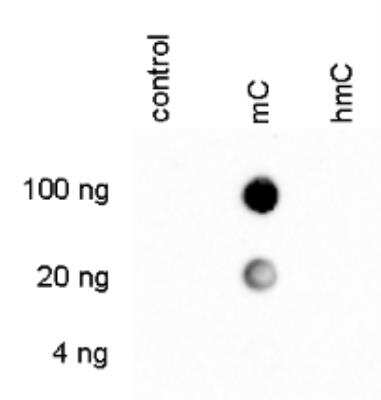5-MethylCytosine Antibody (33D3)
Novus Biologicals, part of Bio-Techne | Catalog # NBP2-54609

Key Product Details
Species Reactivity
Human, Mouse, Rat, Bovine
Applications
Dot Blot, Immunocytochemistry/ Immunofluorescence, Immunofluorescence, Methylated DNA Immunoprecipitation, Surface Plasmon Resonance
Label
Unconjugated
Antibody Source
Monoclonal Mouse IgG1 Clone # 33D3
Concentration
Please see the vial label for concentration. If unlisted please contact technical services.
Product Specifications
Immunogen
5-methylcytosine
Clonality
Monoclonal
Host
Mouse
Isotype
IgG1
Scientific Data Images for 5-MethylCytosine Antibody (33D3)
Immunocytochemistry/ Immunofluorescence: 5-MethylCytosine Antibody (33D3) [NBP2-54609]
Immunocytochemistry/Immunofluorescence: 5-MethylCytosine Antibody (33D3) [NBP2-54609] - HeLa cells were stained with the antibody against 5-mC and with DAPI. Cells were fixed with 4% formaldehyde for 10 minutes and blocked with PBS/TX-100 containing 1% BSA. The cells were immunofluorescently labelled with the 5-mC antibody (middle) diluted 1:500 in blocking solution followed by an anti-mouse antibody conjugated to Alexa Fluor 594. The left panel shows staining of the nuclei with DAPI. A merge of the two stainings is shown on the right.Surface Plasmon Resonance: 5-MethylCytosine Antibody (33D3) [NBP2-54609]
Surface Plasmon Resonance: 5-MethylCytosine Antibody (33D3) [NBP2-54609] - A synthesized biotin-labeled 5-mC conjugate was immobilized on a sensorchip. Briefly, two flowcells were prepared by sequential injections of EDC/NHS, streptavidin, and ethanolamine. One of these flowcells served as negative control, while biotinylated 5-mC conjugate was injected in the other one, to get an immobilization level of 55 response units (RU). All SPR experiments were performed, using HBS-N buffer (10 mM HEPES,150 mM NaCl, pH 7.4), at a flow rate of 5 uL/min. Interaction assays involved injections of 2 different dilutions of the 5-mC monoclonal antibody over the biotinylated 5-mC conjugate and negative control surfaces, followed by a 3 minute washing step with HBS-N buffer. At the end of each cycle, the streptavidin surface was regenerated by injection of 0.1M citric acid (pH 3). The value of the dissociation constant (kd) obtained by global fitting and 1:1 Langmuir model is 65 nM.
Dot Blot: 5-MethylCytosine Antibody (33D3) [NBP2-54609] - To demonstrate the specificity of the antibody against 5-mC, a Dot blot analysis was performed using hmC, mC and C controls. 100 to 4 ng (equivalent of 5 to 0.2 pmol of C-bases) of the controls were spotted on a membrane. The antibody was used at a dilution of 1:300. Figure shows a high specificity of the antibody for the methylated control.
Applications for 5-MethylCytosine Antibody (33D3)
Application
Recommended Usage
Dot Blot
1:100
Immunocytochemistry/ Immunofluorescence
1:500
Immunofluorescence
1:500
Methylated DNA Immunoprecipitation
0.5 - 1.0 ug/IP
Formulation, Preparation, and Storage
Purification
Protein A purified
Formulation
PBS
Preservative
0.05% Sodium Azide
Concentration
Please see the vial label for concentration. If unlisted please contact technical services.
Shipping
The product is shipped with dry ice or equivalent. Upon receipt, store it immediately at the temperature recommended below.
Stability & Storage
Store at -80C. Avoid freeze-thaw cycles.
Background: 5-MethylCytosine
Alternate Names
5-mC, 5-Methyl Cytosine, Cytosine (5-Methyl)
Additional 5-MethylCytosine Products
Product Documents for 5-MethylCytosine Antibody (33D3)
Product Specific Notices for 5-MethylCytosine Antibody (33D3)
This product is for research use only and is not approved for use in humans or in clinical diagnosis. Primary Antibodies are guaranteed for 1 year from date of receipt.
Loading...
Loading...
Loading...
Loading...
![Surface Plasmon Resonance: 5-MethylCytosine Antibody (33D3) [NBP2-54609] Surface Plasmon Resonance: 5-MethylCytosine Antibody (33D3) [NBP2-54609]](https://resources.bio-techne.com/images/products/5-MethylCytosine-Antibody-33D3-Ovalbumine-Surface-Plasmon-Resonance-NBP2-54609-img0015.jpg)

![Methylated DNA Immunoprecipitation: 5-MethylCytosine Antibody (33D3) [NBP2-54609] Methylated DNA Immunoprecipitation: 5-MethylCytosine Antibody (33D3) [NBP2-54609]](https://resources.bio-techne.com/images/products/5-MethylCytosine-Antibody-33D3-Methylated-DNA-Immunoprecipitation-NBP2-54609-img0023.jpg)
![Immunocytochemistry/ Immunofluorescence: 5-MethylCytosine Antibody (33D3) [NBP2-54609] Immunocytochemistry/ Immunofluorescence: 5-MethylCytosine Antibody (33D3) [NBP2-54609]](https://resources.bio-techne.com/images/products/5-MethylCytosine-Antibody-33D3-Immunocytochemistry-Immunofluorescence-NBP2-54609-img0022.jpg)